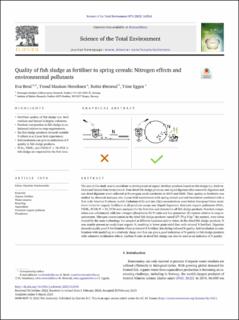Quality of fish sludge as fertiliser to spring cereals: Nitrogen effects and environmental pollutants
Peer reviewed, Journal article
Published version
Permanent lenke
https://hdl.handle.net/11250/3093675Utgivelsesdato
2023Metadata
Vis full innførselSamlinger
- Articles [3012]
- Publikasjoner fra CRIStin [3070]
Sammendrag
The aim of this study was to contribute to development of organic fertiliser products based on fish sludge (i.e. feed residues and faeces) from farmed smolt. Four dried fish sludge products, one liquid digestate after anaerobic digestion and one dried digestate were collected at Norwegian smolt hatcheries in 2019 and 2020. Their quality as fertilisers was studied by chemical analyses, two 2-year field experiments with spring cereals and soil incubation combined with a first-order kinetics N release model. Cadmium (Cd) and zinc (Zn) concentrations were below European Union maximum limits for organic fertilisers in all products except one (liquid digestate). Relevant organic pollutants (PCB7, PBDE7, PCDD/F + DL-PCB) were analysed for the first time and detected in all fish sludge products. Nutrient composition was unbalanced, with low nitrogen/phosphorus (N/P) ratio and low potassium (K) content relative to crop requirements. Nitrogen concentration in the dried fish sludge products varied (27–70 g N kg-1 dry matter), even when treated by the same technology but sampled at different locations and/or times. In the dried fish sludge products, N was mainly present as recalcitrant organic N, resulting in lower grain yield than with mineral N fertiliser. Digestate showed equally good N fertilisation effect as mineral N fertiliser, but drying reduced N quality. Soil incubation in combination with modelling is a relatively cheap tool that can give a good indication of N quality in fish sludge products with unknown fertilisation effects. Carbon/N ratio in dried fish sludge can also be used as an indicator of N quality.
